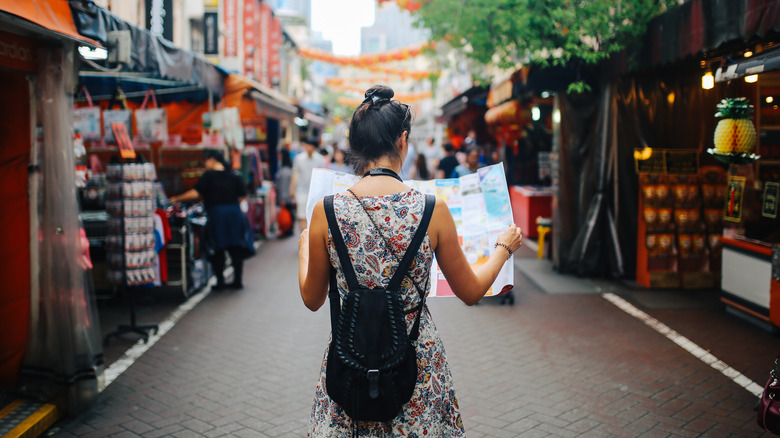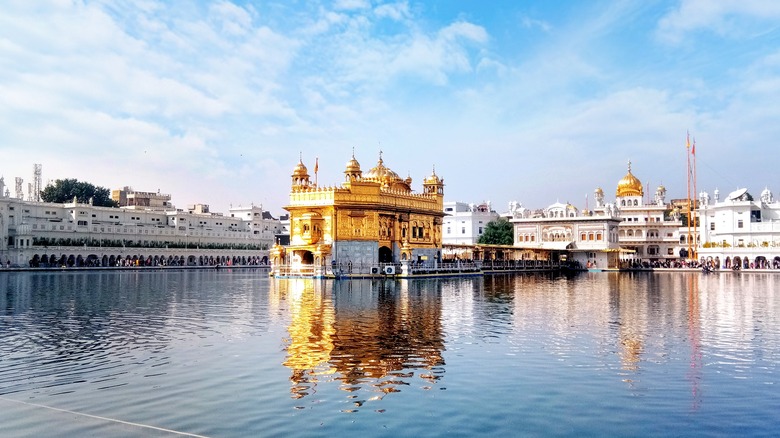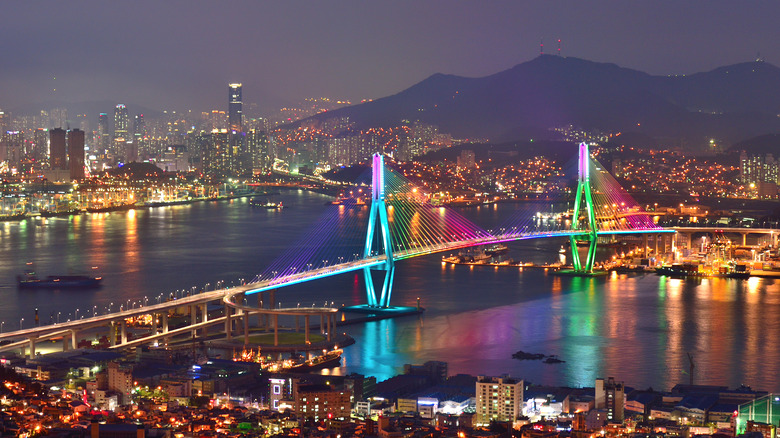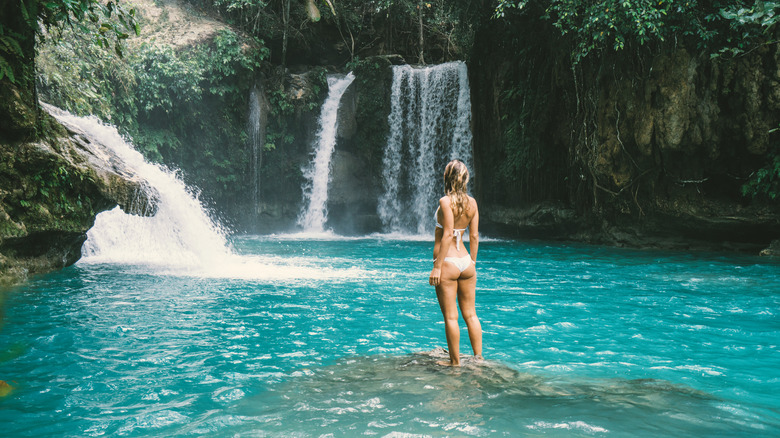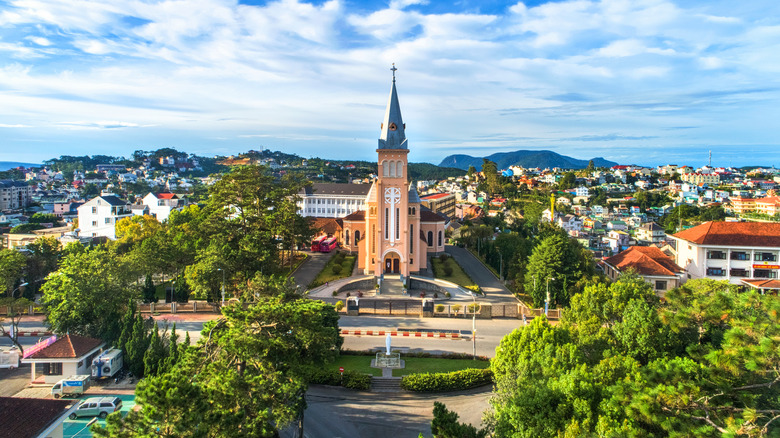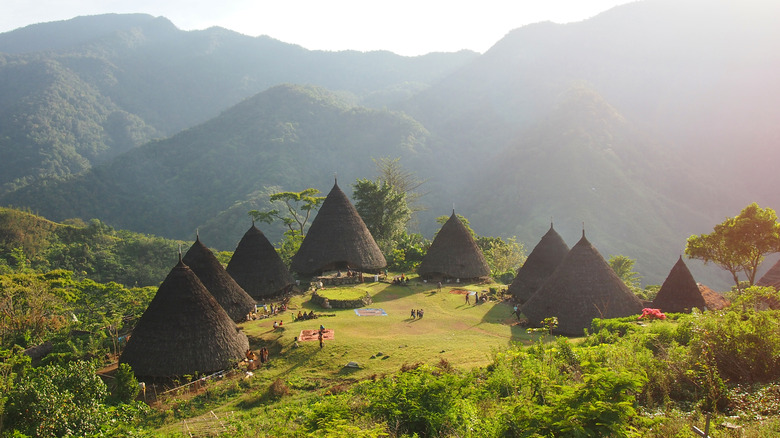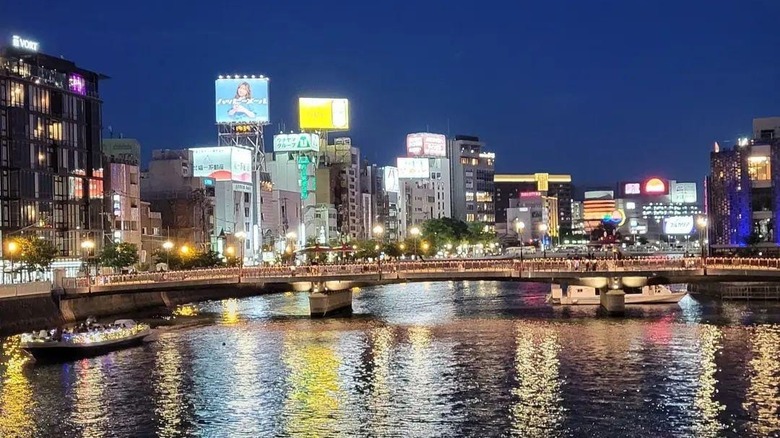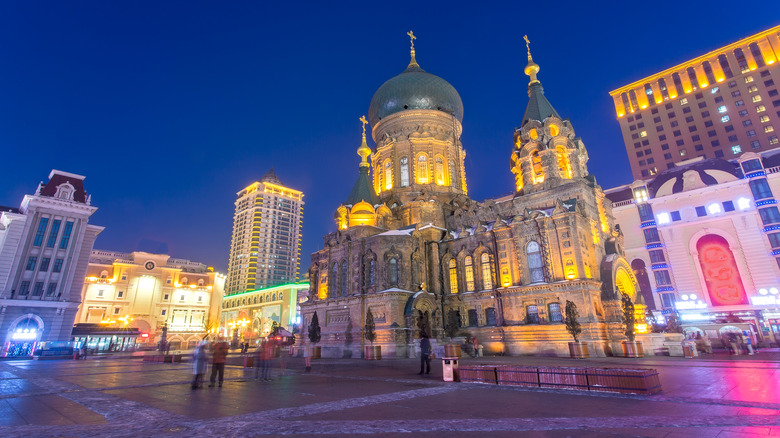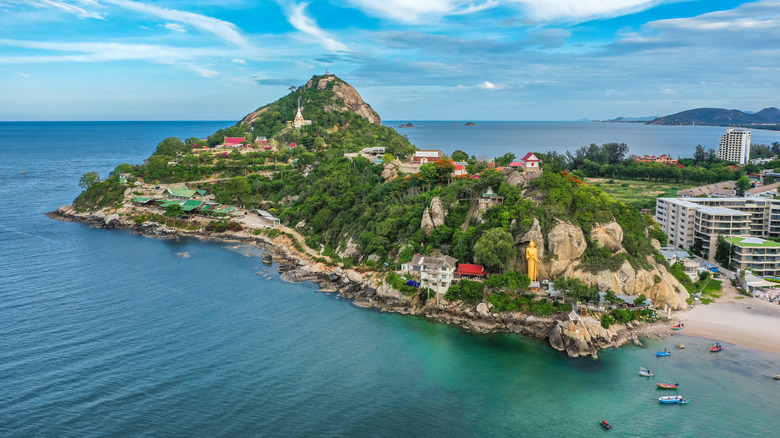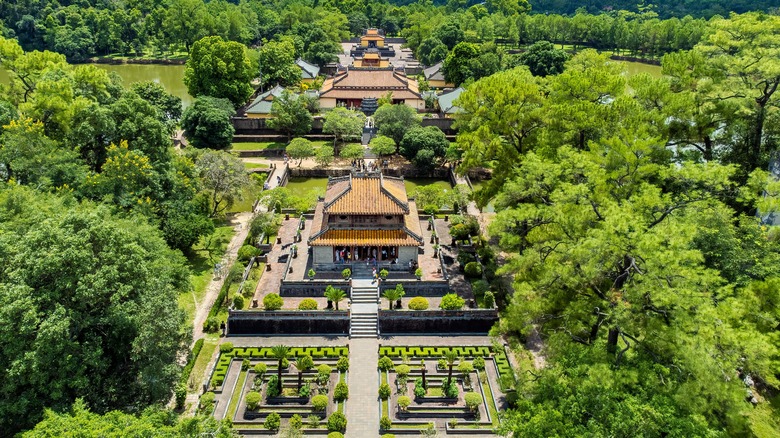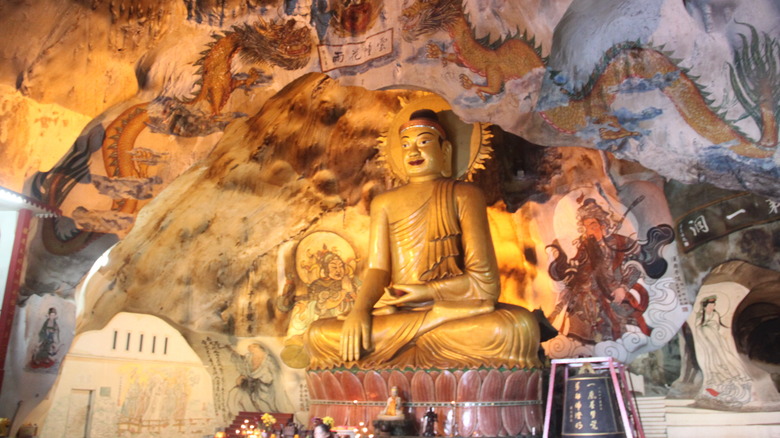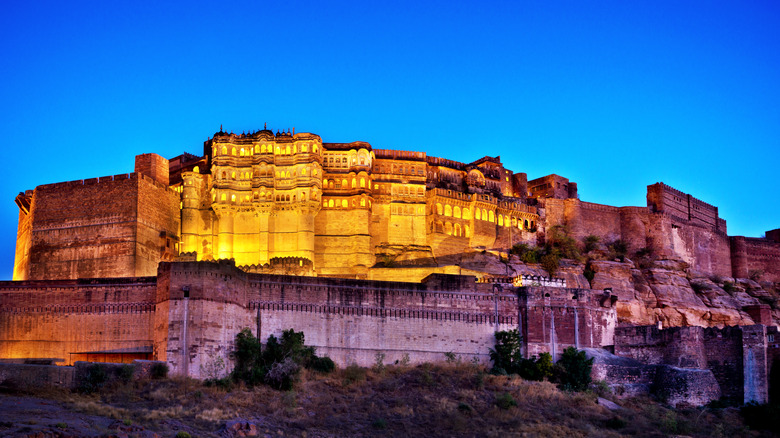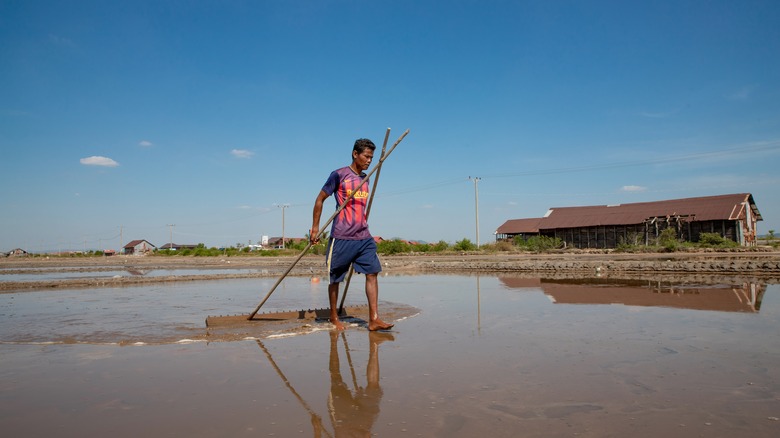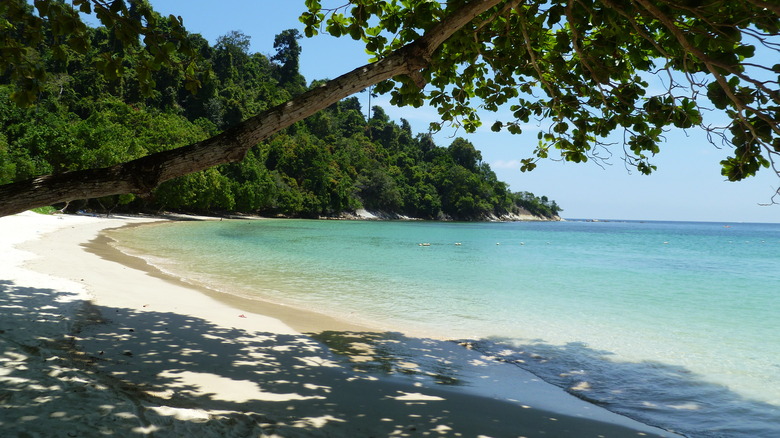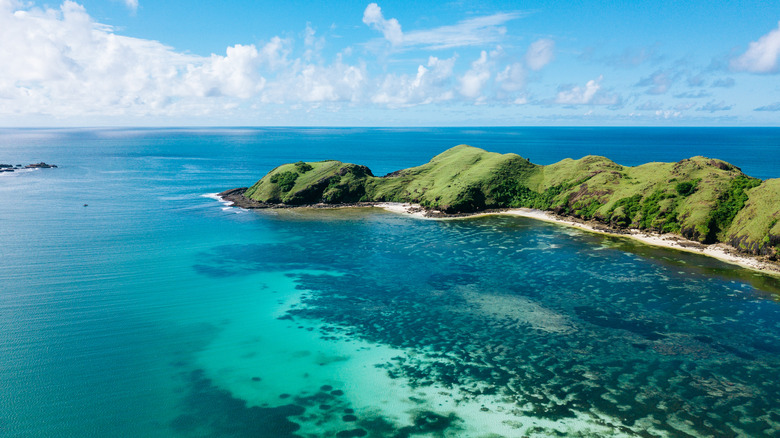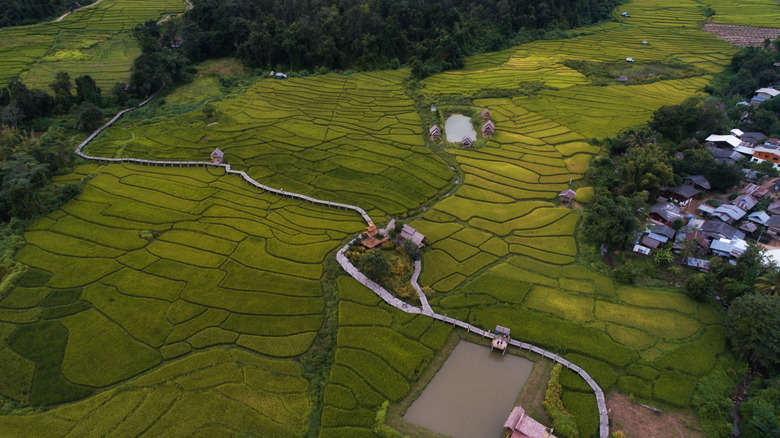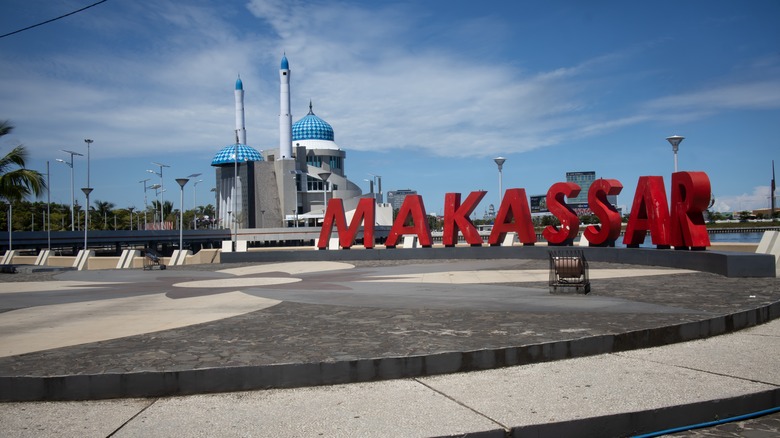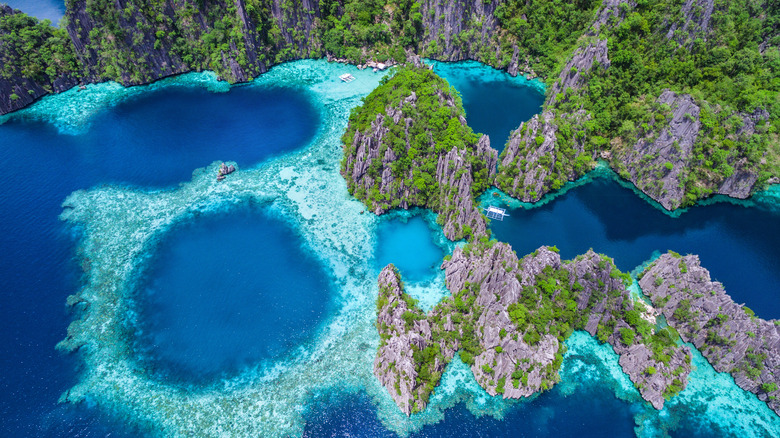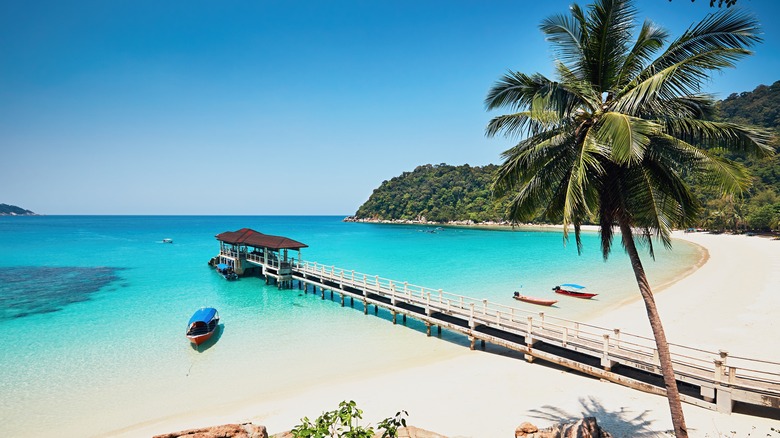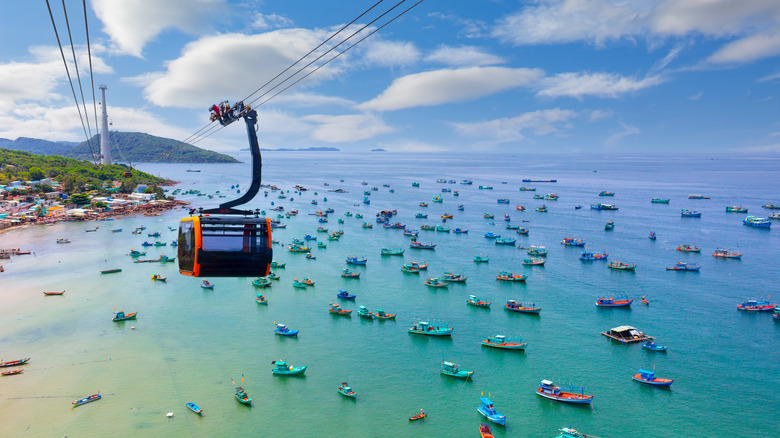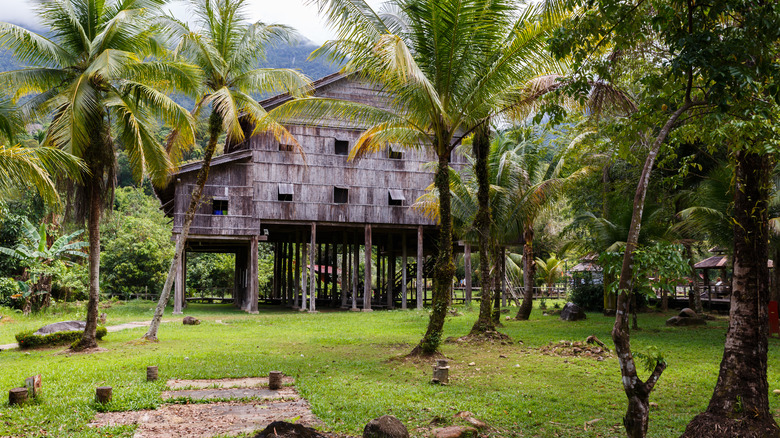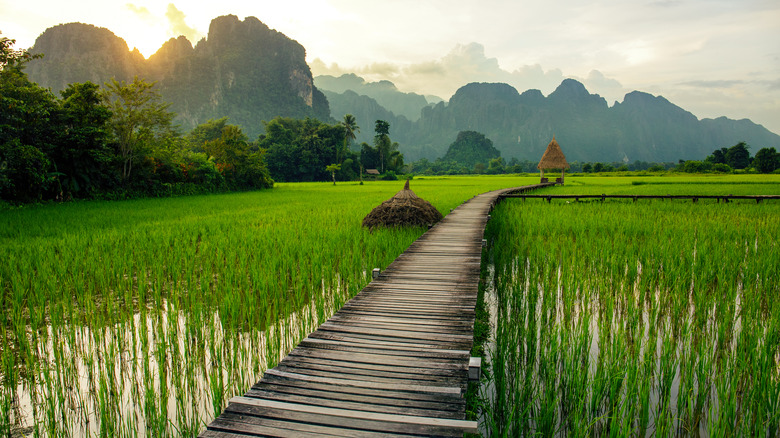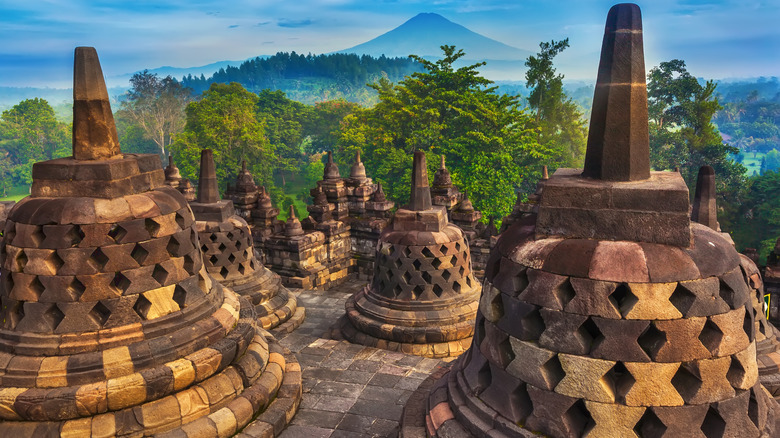22 Underrated Tourist Destinations In Asia To Add To Your Bucket List
The world's most populous continent — Asia is home to 60% of the earth's population — is blessed with dizzying variety. That diversity extends not just to the topography here, with the world's highest mountain and some of the greatest beaches, both found on the continent, but also to the culture and the sheer number of things to see. And yet, visitors to Asia largely focus on the standard destinations, a kind of well-worn circuit of places that one can easily name off the top of their head.
Yes, these spots are worth seeking out, but they don't tell the whole story. In reality, they only really scratch the surface of Asia — for every Bangkok and its ornate royal temples, other destinations in Thailand will have travelers gazing on in awe and wonder. The buzzing streets and architecture of Shanghai and Tokyo are the stuff of legends, but what about some of the lesser-known gems? This list below doesn't claim to present a complete alternative compendium to the standard Asian highlights. However, consider them a great start when looking for options to explore in this wildly inventive, energetic, and spellbinding slice of the globe.
Amritsar, India
The Northern Indian city is the spiritual heart of the Sikh religion, with its beating core at the Golden Temple. A striking piece of gilt architecture, it stands in the middle of a larger complex, the central point distinct for its shimmering gold form against the white buildings all around. The temple is filled with real gold and precious gems, but its design is grounded in humility, and the importance of all people, which is why it has four entrances, to signify it is a place that welcomes everyone. Indeed people of any faith, or no religious affiliation at all, can visit the temple, which is more than 400 years old and enjoy its langar sewa. This is a free meal that is a hallmark of all Sikh temples, or gurudwaras, around the world — here, thousands of people are served food every day.
Food is another major draw to the city, and Amritsar has some of the best meals anywhere on the continent, much of it available close to the Golden Temple. From the simple, hearty breakfasts of chole puri (curried chickpeas served with fried, puffy, bread) to the sugary, melt-in-your-mouth sweet gulab jamun, visitors are unlikely to visit this city and complain of hunger.
Busan, South Korea
The second-largest city in South Korea, closer to Japan than the country's capital, Busan sits on the country's southeast coast and is a popular retreat for Koreans wanting beach time. Movie fans might know its name from the zombie horror sensation "Train to Busan," a smash hit that follows a fated train as it travels between Seoul and the coastal city, its passengers slowly turning, one by one, into the undead. Thankfully there is nothing to fear in Busan; it's a very welcoming city with plenty to see and do, and the seascapes are quite magnificent.
An obvious starting point is Haeundae Beach, a mile-long stretch of sand that is a magnet for sun worshippers in the summer. In the area behind the beach, travelers will find many food stalls in Haeundae Market, selling beloved local snacks and eats, and even for visitors that don't want to dine here, it's an interesting place to wander. A defining part of the city's panorama is the Busan Gwangandaegyo Bridge, which is almost 5 miles long and gorgeously lit at night as it snakes its way over the water, connecting different parts of the city. The city is also home to great cultural offerings, including the annual fall Busan International Film Festival, one of the largest film fairs in Asia.
Cebu, Philippines
A country of islands with more than 7,000 spread around the South China Sea, the Philippines is blessed with a wealth of beaches, from its northern stretches that reach up toward Taiwan to its southern points that commune close to Indonesia. Visitors can experience some fabulous sandy shores around the island of Cebu, an isle about 125 miles long ringed by many coral reefs. However, the destination isn't just attractive for its beaches because Cebu is a cultural hotspot.
This is where visitors will be able to watch the annual Sinulog festival, held in January, a religious commemoration characterized by huge parades of people dressed in vibrantly colorful costumes, ending with a grand fireworks display. For Filipinos, the festival is such a draw that millions come to see it every year. Some of these visitors also make sure to visit Kawasan Falls, a gorgeous set of cascades that eventually drops into a picturesque pool of turquoise water.
Da Lat, Vietnam
Vietnam's big cities — Hanoi, Ho Chi Minh City — are frenetic, packed places, where scooters jam the roads and commerce courses through the streets and alleys. A refreshing alternative to this tiring cityscape appears in Vietnam's highlands, in the country's south-central band. Here, the weather feels like eternal spring, and Da Lat (also spelled as Dalat) is a refreshing escape from the humid, dense experience that is a hallmark of time in the big cities.
Visitors can wander the town's quiet streets and enjoy French colonial architecture — the city was a cool-weather refuge for administrators when the country was part of French Indochina — and even a summer palace of a former emperor. For adventure travelers, this is also a city not to miss. Thrill-seekers can book a tour with Phat Tire to go canyoning along the waterways and waterfalls around the town. They can also take a mountain bike ride around the rippling hills, a rolling terrain that is cool and shrouded in mist in the mornings.
Flores, Indonesia
Visitors worldwide know about Bali, and the island has done a wonderful job piecing together its strong tourist infrastructure. But Indonesia, a nation with thousands of islands strewn on either side of the Equator in Southeast Asia, has so much more to offer and promises a variety that makes the eastern and western parts of the country feel wildly different. On the island of Flores, which sits roughly in the middle of the country, from west to east, nature is a sight to behold. There are large tracts of unspoiled forest, and at Mount Kelimutu National Park, a volcanic park, the views take in craggy hills and a trio of bubbling, mystical lakes that seem to change color depending on the weather conditions and light. Looking at them is an awe-inspiring experience.
The seas around the island are also stunning, calm, and ridiculously clear, turquoise in color and warm to the touch. And for visitors that want to see a unique, ancient settlement up close, a trip to Wae Rebo Village is a real treat. Access to the village, up on a plateau in the mountains, requires a three-hour trek, but once here, visitors will catch sight of conical homesteads surrounded by greenery and think they have encountered pure magic.
Fukuoka, Japan
Located in Kyushu, the most southern of Japan's four main islands, Fukuoka pulls visitors from across the country for its great food scene. The city is known for its Hakata ramen, made with tonkotsu, or pork-bone broth, prepared by boiling pork bones for an eternity until they eventually disintegrate to create a deep flavor stock. This delectable specialty is available throughout the city at a yatai (or food stall), from famed spots in busy areas to little tucked-away counters in train stations. Some of the most sought-after stalls can be found in the Tenjin and Nagahama parts of the city, while the chain Ichiran (which also has outlets in New York City) has its flagship restaurant in the city.
Beyond the food, visitors can easily spend days exploring Fukuoka. Shoppers will gape in wonder at the vast footprint of Canal City Hakata mall, split by a long waterway and home to many shops and performing arts shows. Dazaifu Tenmangu is a place of worship and cultural center where time almost feels like it stands still, while the bronze Buddha statue — one of the largest in the world — at Nanzoin will have visitors gaping in amazement.
Harbin, China
In China's northeast, closer to the border with Russia than to the capital Beijing, Harbin spreads out alongside the Songhua River. There are touches of the northern neighbor evident here. The St. Sophia Cathedral looks like it was pulled right out of Moscow, built more than a century ago and dominated by the green dome shaped like an onion. It sits in a plaza, making it a main focal point and allowing travelers to take great photos from multiple angles. Elsewhere around the city, other Neoclassical buildings appear.
Yet, more than these landmarks, visitors most fervently come for the annual ice festival, a marvel of engineering and an unforgettable spectacle. With ice sculptures appearing around the city during the festival's length — it usually takes place from late December to early February — the whole destination feels like a giant showcase for the event.
However, the most intricate sculptural works are at a few specific sites, with the vast majority of them at Ice and Snow World (paid entry is required). Here, skyscrapers made of ice are illuminated in multiple colors, so plan to arrive shortly before sunset and stay for the evening when the sculptures are lit up. At times, you'll scratch your head in wonder, trying to understand how these ice formations were built (artists use blocks of ice harvested from the river), and the level of workmanship and ingenuity is astounding.
Hua Hin, Thailand
This easy destination is a few hours by car from Bangkok and is a worthy place to seek out terrific beaches. This part of Thailand, in fact, was a retreat for the royal family, and just north of Hua Hin, visitors can drop by the Maruekhathaiyan Palace, a summer refuge for the king and queen, built in the 1920s and constructed of teak. In the town itself, long stretches of soft, silky sand yield to the waters of the Gulf of Thailand, and plush properties make the most of the waterfront setting.
The resort Chiva Som has long lured travelers with its beachfront location and an impressive roster of wellness services, from medical testing to spa treatments. At the southern end of the town, the temple Wat Khao Takiap sits on a hill that rises from the water and features hilltop shrines and a gleaming gold Buddha statue that stands tall, like a sentry guarding the sea.
Hué, Vietnam
There is deep history in this city located in Central Vietnam. Set on a river, it was where the Nguyen Dynasty decided to set up its capital, an area where the riverbanks were good for growing crops, and the forested hills provided a verdant base. The legacy of these rulers is evident in the city's ornate buildings, from towering pagodas and shrines to the tombs where many emperors are buried. The dynasty ruled here for almost 150 years and was the last such body to govern; its former power and influence courses through the citadel.
Hué is a beautiful place to visit, and beyond the historic structures, travelers will delight in the charming, tree-lined street, as well as a handsome stock of Art Deco homes. A must-see is the Thien Mu Pagoda, rising seven tiers and as inspiring for its angular form as for its height. Wanderers can also sate their gustatory lust with a scrumptious dish that originated from this city. Bún bò Hué is a hearty, fragrant soup that features beef, pork, and a rich injection of fresh herbs, and, no surprise, is widely available throughout this former imperial stronghold.
Ipoh, Malaysia
A couple of hours northwest of the Malaysian capital Kuala Lumpur, this small city has a mix of manmade pleasures and hypnotic natural wonders. In town, intrepid visitors will find a number of cool eateries that mix high style with great food, especially along Jalan Sultan Yussuf. Indeed food is a big part of the appeal of the Ipoh (some say it's thanks to the local water), and a visit here invariably includes a plate of chicken and beansprouts at Restoran Tauge Ayam Lou Wong.
Ipoh also promises excellent exploration in the countryside, notable for its hulking limestone hills and mountains. Numerous caves sit around the city, not surprising given the predominance of limestone here, and some have been shaped into temple complexes. The Perak Cave Temple has striking murals inside the cave walls and a walk to the summit of a hill that offers expansive views of the city and its environs.
Jodhpur, India
The fort dominates the skyline of this city in northwest India, a commanding presence for all to see. At the top of the list for most travelers, Mehrangarh Fort rises into the sky, sitting atop a cliff hundreds of feet above the rest of the city. It's a beautiful structure to explore, made of sandstone, and ornately compiled, with finely screened windows and grand public spaces with stained glass windows, mirrored ceilings, rooms that give visitors an opening onto the life of the royals, and displays that detail the fort's rich past. Wandering up and down the fort, winding through its tight spaces and narrow stairways, transports visitors back in time.
Looking down from the fort, travelers will see a section of the city where the houses are all painted in blue, denoting, some believe, residents who hail from the highest caste in Hinduism. Another worthwhile stop is at Jaswant Thada, a marble mausoleum built more than a century ago to honor a local royal by his son. For some, it's as visually pleasing as the Taj Mahal. Travelers should also use Jodhpur as a base for trips to the Thar Desert, just beyond the city limits, perhaps for a camel ride at sunset.
Kampot, Cambodia
There's a beautiful, easy-going charm to this town in southern Cambodia, a three-hour drive from the capital, Phnom Penh. Located on a river a little inland from the sea, it might remind visitors of another Southeast Asian town with a magnetic laid-back vibe, Luang Prabang. But Kampot hasn't yet drawn as many tourists as that city in Laos and has retained a somewhat undiscovered atmosphere. Yes, many come here from the capital over the weekend to take a boat trip down the river to see fireflies or enjoy the relaxed cafes, restaurants, and ice cream shops along the river and in the blocks further back. And many expats have come here to set up businesses while enjoying the serene lifestyle. But even after all that, Kampot feels refreshingly stress-free.
Time here slows down, allowing visitors to soak up the ambiance. They can take trips to the nearby Bokor National Park, a grand, flat mountainous area on the edge of town that has great views over the sea to the south, and the Vietnamese island of Phú Quôc, just offshore. Or partake in some agri-tourism — Kampot is famous for its fleur de sel salt, like that harvested by Thaung Enterprise, and pepper, such as the varieties grown at La Plantation, a short drive outside the city.
Kota Kinabalu, Malaysia
This city in the Malaysian part of Borneo has a lively waterfront area, great seafood restaurants and a vibrant, albeit tourist-primed, craft market by the sea. But many visitors use it as a springboard for the outdoor adventures that lie close by. The town is named for the nearby Mount Kinabalu, a peak that mountaineers like to summit to add another notch to their belt. It's certainly a challenging endeavor, the tallest mountain in Malaysia, topping out at 13,435 feet above sea level and one of the loftiest peaks in Southeast Asia.
While not as arduous a climb as some of the other mountains in Asia, it definitely requires visitors to be fit, and authorities also limit the number of climbers allowed on the mountain at any one time to ensure no over-crowding. Trips to the peak usually require an overnight stay along the way. Much more manageable are the excursions to the aquatic delights of Tunku Abdul Rahman Park, a marine reserve just off the coast from Kota Kinabalu, with vibrant reefs, plenty of sea life (including the ever-popular clown fish), and clear seas that are a joy to leap into.
Lombok, Indonesia
Bali might be a tourism behemoth, not just in Asia but globally, but just next door, another Indonesian island has a much less touristy feel. Lombok is far less developed than Bali, and direct flights here are only available from Malaysia, Singapore, and within Indonesia (compared to Bali, which has direct connections to cities in Australia, the Middle East, China, and Europe). But Lombok is a charming place, with plenty to explore. Visitors can start with a trek up the volcano of Mount Rinjani, whose top is more than 10,000 feet above sea level, and where the water-filled crater at the summit is an unforgettable sight.
The countryside is also dreamy, and travelers can take photos of the same kinds of rice paddies that are such an enduring image of life in Bali. The beaches, arguably, are better in Lombok than in Bali, with perhaps the pick of the clear water on the Gili islands ("gili" translates to "small island" from the local Sasak dialect), little isles that sit off the north coast of Lombok. Here, visitors enjoy a relaxed beach way of life, with swimming, snorkeling, diving by day, eating, drinking, and partying by night (certainly on Gili Trawangan, the other islands are much quieter).
Mae Hong Son, Thailand
Thailand isn't just frantic, supercharged cities like Bangkok and dreamy, languid beach havens like Koh Samui and Phuket. It's also covered by huge areas of greenery, forests and jungles that blanket much of its interior. For travelers keen to explore the mountainous countryside of Thailand, they should consider Mae Hong Son. The city, known for its misty conditions because it sits in a valley hemmed in by mountains on many sides, is where to find peaks, trees, and flowers galore, and its cool climes are a refreshing alternative to the country's tight cities and humid beaches. Mae Hong Son is great for hikes in the mountains and the chance to get close to some of Thailand's ethnic tribes who live in villages set among the hills and forests around the city.
The explorations offer visitors another facet of the country's riches, a less familiar aspect of Thailand that is equally compelling as the buzzy metropolises and sultry stretches of sand, and some operators can arrange for overnight homestays in these villages. Other activities in the area include treks with elephants, white water rafting, and excursions into national parks. The architecture here also differs from other parts of Thailand, with temples that espouse Lanna vernaculars (the roofs are steeper and more pitched). For fans of temple culture, Mae Hong Son is home to an annual festival where young Buddhist monks are ordained, an event known as Poi Sang Long.
Makassar, Indonesia
This city in the south part of the Indonesian island of Sulawesi grew in prominence due to its importance as a port. It played a key role in the maritime trade of goods shuttling with Indonesian islands to the east and west during Dutch colonization. Some of the faded past is evident today in the city, and Makassar is populated with fine old structures. Among the most entrancing is Fort Rotterdam, a red-roofed stronghold first built in the 16th century and originally constructed before the arrival of the Dutch here, by a local king, in the shape of a turtle. The Dutch recast its use as a storage area for precious items — herbs and spices, which were incredibly valuable at the time — and named the complex Fort Rotterdam.
The attraction is close to Losari Beach, a promenade (no beach here) with fine walks along the water and plenty of places to eat nearby. Travelers who want to dive into some stunning seas can take a short trip to the Spermonde islands, coral isles off the coast of Sulawesi, some of which are easily accessible from Makassar. To call the water here gorgeous is an understatement.
Palawan, Philippines
The Philippines allows travelers to choose from scores of islands, and clear, ravishing waters, of course, but for devotees of this most simple, and perhaps calming, or natural attribute, can any island compare with Palawan? A long, skinny island that sits in the west of the country, and north of the island of Borneo, Palawan is a paradise for any fan of the sea. The crystalline waters here are some of the most breathtaking anywhere in Asia and with some of the other coastal topography, making this a destination that might, at times, feel like a place that exists only in fantasy.
Most flights to the island arrive at Puerto Princesa. While the city doesn't have much to hold one's attention, it is the launch pad for trips to the Puerto-Princesa Subterranean River National Park. This Unesco World Heritage site features an underground waterway with unique fauna that terminates directly into the sea. Exploring it by kayak is something visitors will never forget.
Another part of the island, El Nido, sits on the northern end of Palawan and has long been a favorite of travelers in the know, with gorgeous beaches and water that urge adventurers to dive in. Just offshore, north of El Nido, Coron promises vistas that will amaze visitors, with steep limestone karst cliffs, impossibly clear turquoise waters, and reefs below the shallow depths.
Perhentian Islands, Malaysia
Two tiny islands off the east coast of Peninsular Malaysia (the country is split into two parts, with one part a peninsula connected to the mainland of the continent of Asia, the other part carving out a piece of the island of Borneo to the east), these specks promise visitors beaches that are sublime. Getting to the Perhentians requires some effort, with no direct flights or simple transfers from big cities. Access is via a ferry ride from the small town of Kuala Besut, and the quick trip brings visitors to one of the two islands — Perhentian Besar and Perhentian Kecil (meaning Perhentian big and small).
The atmosphere on the two islands differs, with Besar a little more developed for the average tourist and a little pricier and Kecil more focused on the backpacking market, but both open up to exquisite beaches and the type of clear seas that immediately put the heart and soul at rest. Snorkeling and diving are fantastic; water bunnies will likely see turtles, clownfish, and much more on the nearby reefs.
Phú Quôc, Vietnam
Another great beach destination, this island in Vietnam, is closer to Kampot in Cambodia than Vietnam. For anyone visiting Vietnam in search of glimmering blue seas set beside gleaming white sand, this is the place to seek out, with the island falling within the Unesco-accredited Kien Giang Biosphere Reserve, meaning its waters are protected. Age-old farming and fishing practices continue here, but tourism is earning the island a decent chunk of change, and resorts dot the comely shores. The coast around Phú Quôc is almost 100 miles long, and resorts of all sorts are available to visitors — from small independent properties to larger offerings run by well-known European and American hotel brands.
The water here is a salve for the spirit, while the seemingly never-ending stretch of Long Beach, on the island's west, is where to watch sunsets that will move the soul. There is also an adventure in the isle's interior, with chances to hike on the hills, forests, and mountains inland. Tour a factory that produces fish sauce, a key ingredient in Vietnamese cooking, for a unique excursion.
Sarawak, Malaysia
This state in Malaysian Borneo has something to excite everyone, from nature to food to culture, and it's easy and cheap to get around. Visitors should base themselves in the city of Kuching, the state's capital, which hugs the banks of the Sarawak River. Travelers might notice an assortment of cat statues in the city, and this is because Kuching (or kucing in its Malay spelling) is the local word for cat; taking photos next to them is a fun activity. The city is also famed for its food scene, and one specialty not to be missed is Sarawak laksa, a sour, spicy soup made with tamarind, lemongrass, chicken, and prawns.
A short drive outside the city, but light years away in atmosphere, Bako National Park is an outdoors wonder. Set on the coast, it features jungles, forests, waterfalls, mangroves, beaches, haunting rock formations out in the sea, and hiking trails that let visitors explore the park's many facets. The main draw for many visitors is seeing the proboscis monkey, an endangered animal with a surprisingly bulbous nose. Other wildlife include bearded wild boar, flying lemurs, and slithering monitor lizards. Travelers can even organize an overnight stay in the park. Another lure near Kuching is the villages of the Bidayuh. This tribe lives in this part of Sarawak and has historically resided in long, communal longhouses that are a feat of engineering and a sight unlike any other.
Vang Vieng, Laos
The landlocked country of Laos has long attracted a certain type of overseas traveler — one that enjoys a sedate, peaceful, almost off-the-grid way of life, where the enjoyment of the destination is less about the volume of sights and experiences and more about the chance to unlink from daily life and decompress. For many years, the small town of Vang Vieng was an anomaly to that philosophy, a party town where young travelers, predominantly backpackers, would come to tube down the river here, drink, get high, and party like there was no tomorrow. Much of that has changed in the last decade, and this gorgeous countryside escape has an ambiance more fitting of a peaceful rural getaway.
The tubing is still available, but most of the bars along the Nam Song River have closed down, ensuring that the tube floats down the river is ensconced in peace and nature; it's a great, low-impact way to cool off on a hot day. Outside the town, the land yields rice paddies and towering limestone karst formations, and a walk or cycle around here is a captivating way to spend a morning. Taking a dip in the blue lagoons around town is also great fun, and the waters are hypnotic in their color and calmness.
Yogyakarta, Indonesia
On the Indonesian island of Java, which is also home to the nation's capital, Jakarta, this city is a cultural powerhouse for historical sights outside its limits and a lively art scene that doesn't stop. For many years, this was a center of dynastic power in this part of Asia, and the upshot was the building, more than 1,000 years ago, of magnificent temple complexes nearby. The buildings are still very much alive today, and Borobodur and Prambanan are breathtaking in their scope and workmanship. The former, a Unesco World Heritage site, comprises many stupas and statues geometrically set in a tiered pyramid shape, and the overall effect of the huge Buddhist shrine is almost overwhelming in its bravura.
Similarly designated by Unesco, Prambanan's soaring Hindu temples reach high up into the sky, their forms climbing to a fine point. But Jogja, as many here call it, also has many delights in the city, especially its art scene. There is fabulous street art here, with murals all over the city, including a large selection on the walls around Kridosono stadium. Art is so important here that there is an annual fair, Art Jog, that is a celebration of contemporary art with shows, talks, and events around the city,
